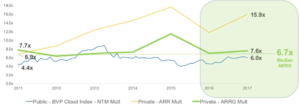From Pieter Welten – Prime Ventures (@pieterwelten)
Investors love the SaaS business model. Why? Because the model relies on subscription-based, predictable, recurring (monthly or annual) revenue streams rather than one-time transactions or upfront fees. In general, high(er) predictability often comes with less risk. Additionally, the business model involves measurable values (or KPIs) that demonstrate how effectively a company is achieving its objectives (such as growth projections). And if you can measure it, you can manage (and improve) it.
Obviously, there are other business models that have recurring revenue streams. Think of mature, online food delivery and ride-hailing businesses. These platforms understand that on a monthly basis a % of their total active customer base will order a pizza or taxi and how S&M marketing spend will translate in new customers.
In my opinion, the primary drivers of company valuations of businesses with recurring revenue streams are revenue growth in combination with underlying profitability. You can derive their net present value of future cash flows from its recurring revenue streams. What is important to realize though, is that part of the enterprise value of such a business should be explained by (i) its existing customer base and (ii) a part by the company’s expected growth and other company specific characteristics. We will zoom into this later on. Furthermore, valuations (or multiples) in private markets can either be discounted (due to size of company or the fact that stock is illiquid) or trigger a premium (due to higher profit margins and faster growth projections).
- Existing Customer Base
To value the existing customer base, you can look at the existing customer base to get a sense of the potential contribution (or ‘renewal margin’) of these customers. In order to calculate the contribution, you annualize revenues and take the gross margin. You get to the next 12 months (‘NTM’) gross profit. Depending on churn / downsell and expansion / upsell rates you can either discount or increase the NTM gross profit.
Afterwards, you have to take into account the associated costs to ‘maintain’ this customer base. Typical costs involve R&D, S&M and G&A. You could take 10% of annual S&M spent (as it requires ‘limited touch’ to let customers renew) and 30% of G&A costs. Since any company needs to constantly innovate its product, you should take 80% of R&D costs to keep your customers happy. All costs should be annualized and deducted from the NTM gross profit to get to the ‘potential contribution’ of this cohort. The potential contribution as a percentage of gross profit is called the ‘renewal margin’. A company with a renewal margin of +25% has strong fundamentals. Finally, in order to value the existing customer base, I would apply EBITDA multiples to the annualized customer contribution.
- Growth Projections
In addition to the value of the existing customer base, you will have to ‘value’ incoming customers (or projected growth and the underlying profitability). You can benchmark this with relevant peers. In order to do so, you can consider the following KPIs and characteristics (this is a non-exhaustive list):
- Growth rate;
- Gross margins;
- Churn / Retention / Upsell / Downsell;
- Payback period;
- Customer ROI; and
- Market size.
At the end of the day you need to benchmark these metrics and characteristics to peers. Does Company X have a higher or lower gross margin, is it growing faster or slower and is the CAC payback period relatively low or long? If Company X operates relatively favourable compared to its peers you could argue that it deserves a premium multiple. You can apply this multiple to the newly projected annualized revenues in order to value the ‘new customer base’. The question what multiple do you either discount or increase?
If you look at Cloud / SaaS companies, you can benchmark growth projections and KPIs by looking at the BVP Cloud Index. According to Bessemer, private cloud company ARR multiples hoover around 15x. The rationale is the fact that they are simply growing (much) faster than public cloud companies (i.e. +100% y-o-y vs. 22% y-o-y). However, if you adjust them for growth, they are more justifiable in their view. Once adjusted they are more or less ‘flat’ as you can see in the figure below. You could adjust the ARR multiple by dividing the ARR Multiple by y-o-y growth, translating in a, ‘ARRG’ metric (or ‘Annual Recurring Revenue to Growth’).

Figure. Bessemer Cloud companies ARR and ARRG development (2011-2017)
Furthermore, according to Morgan Stanley, when it comes to SaaS companies the relationship between EV / Revenues and revenues growth remains strong. Despite the fact that rapidly growing SaaS companies seem to be expensive on traditional valuation metrics and compared to market averages one should realize that underneath the growth is a highly profitable renewal base of customers. That’s the reason why good SaaS companies seem to be protected from large price corrections / swings in the market.
I have emphasized several times before that a fair valuation is important to make good investments. Both entrepreneur and investor will benefit from it on the long term, and especially if things don’t go entirerly according to plan. In order to get to such a valuation one should consider both current trading and the existing customer base as well as future growth projections and behaviour of newly acquired customers. The distinction between existing versus new customer base is not often made, but in my opinion very important if you value businesses with a highly recurring revenu stream. Curious to hear what you think of this approach!
